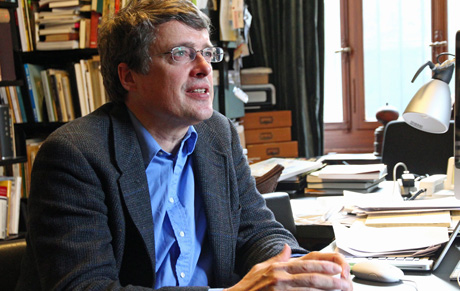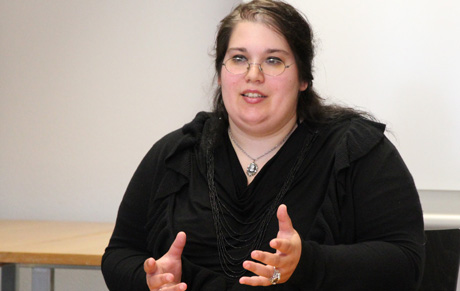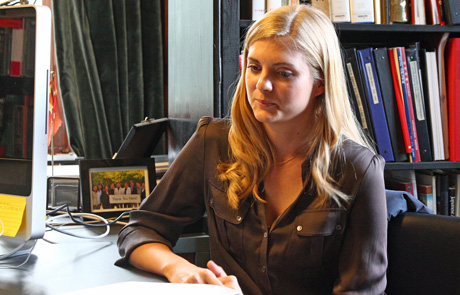Navigation auf uzh.ch
Navigation auf uzh.ch
Doing research in the field of Asia and Europe is always connected with questions of translation. The URPP Asia and Europe’s Research Field 2 “Entangled Histories” is focusing its research efforts on these questions and emphasizing this interest by organizing the 2014 annual conference under the title “Asia and Europe in Translation: Interdisciplinary Perspectives.” Hans B. Thomsen, professor in East-Asian art history and speaker of Research Field 2, as well as Jeanne Egloff and Dinah Zank, doctoral students in East-Asian art history, explain their approach to ‘translation.’
Interview: Roman Benz
Professor Thomsen, Ms Egloff, and Ms Zank, could you explain the interest of Research Field 2 in translation?
Thomsen: Translation is basic to all of us as scholars dealing with Asia, since we are translating words, texts, but also cultural contexts from one language to another. It is part of our disciplines, whether we do research in art history, political science, geography and so forth. For that reason it made sense to have ‘translation’ as a common topic, as it ties together all our fields of interest. Another reason for choosing the topic is that there is enough difference in the way we approach ‘translation’ to make it interesting in terms of a conference. I think it is possible to organize a number of quite different and nonetheless mutally supportive panels.

Could you define your understanding of ‘translation?’
Thomsen: Translation is literally the process of carrying across from one place to another and, of course, by carrying across texts or—more comprehensively—concepts, there is a certain transformation process taking place. The way we transform can also lead to misunderstandings and mistranslations, something that we cannot avoid dealing with cultures that are different from our own.
Zank: From my view as an art historian, the concept of ‘translation’ is especially interesting in comparison with the widespread idea of artists ‘receiving’ foreign influences on their work. The term ‘reception’ supposes a rather passive role of painters, sculptors, or architects in the process of taking over themes, techniques etc., whereas ‘translation’ points to a more active process they are involved in. There has to be an intention when artists start to translate something and they have to think about for which audience they translate. In this sense an artwork can be both a subject of translation indicated by an artist, mediator, connoisseur or whosoever and at the same time function as a translation itself.

Egloff: ‘Translation’ gives access to information what would otherwise remain locked in a foreign language. Sometimes the role of the translator is more interesting than the translation itself: Translators are considered to be discreet and should not interfere with the information they are passing on. But on the other hand, translators automatically express themselves as they report in the language of their audience. As they speak, a subject position is created.

In the field of art history, there is much discussion about the role of translation between different forms of media. Could you give an example of this phenomenon?
Thomsen: One current research question concerns how religious thoughts were translated when European scholars tried to understand East-Asian religions. Typically these thoughts were transferred into forms that were readily understandable for the intended audience and so European models were chosen in order to translate East-Asian and Central-Asian thoughts and concepts. In terms of art history, it is a very interesting process, as images of the deities that accompany these religions were translated at the same time. There are early examples by the German physician and traveler Engelbert Kaempfer (1651–1716) who tried to depict Buddhist deities and how Buddhist temples and rituals work. In our eyes, these representations may seem full of misunderstandings, but we have to analyze them in the context of the early 18th century.
Zank: Somehow, it is an unavoidable problem that you have to draw on a certain vocabulary that is known to the audience for whom you translate. You have to bridge the gap between using this vocabulary and translating accurately foreign cultural and religious concepts.
In my dissertation project, I am scrutinizing how the Japanese painter Yokoyama Taikan (1868–1958) translated images he became acquainted with during his stay in India. One example is his depiction of the Hinduist goddess Kali for a Japanese audience. While depicting Kali in her original Hindu iconography, the artist additionally drew on previous Japanese Buddhist works of art like the “Hibo Kannon” (1883), painted by his compatriot Kanō Hōgai (1828–1888). By using the same composition that was an extremely popular topic of public discussion at this time, the audience could recognize at first glance that Yokoyama is making a comparison between the Indian Hindu goddess Kali and the Buddhist deity of mercy, Kannon. By translating Kali into a Japanese religious context, he builds a cultural bridge and points out a shared Indian and Japanese religious past. At the same time the transformation of the gruesome goddess into a deity of mercy can be viewed as a pictorial translation of cultural and philosophical concepts that Yokoyama learned in India through intellectual actors like Swami Vivekananda (1863–1902) and Okakura Kakuzō (1862–1913). This example of an Asian-Asian translation can illustrate how my project relates to the research interests of Research Field 2 and also to the subject of the next annual conference.
Are there more projects about translation currently running?
Thomsen: My present research is concerned with the tremendous interest that was present in Japan vis-à-vis China during the 18th century. Of course, that involved many processes of translation, not only through images, but also through texts. How Japanese artists translated Chinese themes into their own paintings is one of the most exciting things going on during this period. Itō Jakuchū (1716–1800), for example, created in Kyoto a series of Chinese rooms with Chinese themes, larded with references to Chinese poetry and paintings. He interpreted China through the textual and visual material he had at his hand, namely older Chinese paintings that were present in Japanese temple collections. The entrance to these series of rooms leads through a grove of bamboo, a shorthand reference to the “Seven Worthies of the Bamboo Grove,” a group of Chinese scholars, writers, and musicians of the 3rd century. And if you come into the first room, you look at some chrysanthemums, of course a symbol of the great Chinese poet Tao Yuanming (365–427). By traversing all the rooms you build up step by step a whole set of references to China, rather to an idea of China translated to a specific situation in Kyoto, Japan.
Egloff: In my thesis, I analyze the Japanese term for ‘art’, bijutsu, and the various interpretations of the word and concept during the second half of the 19th century and the beginning of the 20th century. The term was introduced during the preparations for Japan’s first appearance at a world exhibition (Vienna, 1873) and derived from the German terms Kunstgewerbe (arts and crafts) and bildende Kunst (fine arts). As ‘bijutsu’ was a newly coined term, it is interesting to see what type of traditions and artifacts were included or excluded according to different cultural values in Japan and the West during that time.
To come back to the annual conference again, what panels are planned?
Thomsen: The conference tries to involve different traditions and discourses of translation. The starting panel is devoted to theoretical and historical considerations and has as its point of departure a focus on specific contexts and media of translation. There will be panels on the translation of literature in different cultures; on knowledge transfers, e. g. translations of scientific texts and concepts between medieval Arabic and European cultures or geographical knowledge in the form of maps that traveled between Persia and East Asia; or on the spread of Buddhism from India to other parts of Asia. A different kind of visual translation will be examined in a panel focusing on the transmission of artistic models and concepts to neighboring countries and regions. Post-colonial approaches to cultural translation will be considered too, especially in their applicability to film and digital media.
What goals do you want to achieve by organizing the conference?
Thomsen: We would like to connect different fields and disciplines that are engaged in research concerning Asia and Europe—from anthropology, art history, cultural studies, film studies, geography, history, the history of science, linguistics, literature studies, and religious studies to philosophy—and we hope to foster some new insights into the very old topic of translation. It will be interesting to see what ideas and concepts and perhaps what future directions will come out of the conference and how it will influence the further work of Research Field 2.
Besides all theoretical considerations we should not forget that there is no such thing as a perfect translation. They are all mistranslations on a certain level. This understanding of mistranslation, of not being able to translate fully correctly, is something I would like to put into the center of the conference and to discuss thoroughly. The awareness of mistranslation tends to get lost now as we more or less assume that technology can do this work for us. It really cannot, we have to step in, we have to make compromises, we have to reflect on the translation process from time to time.
Zank: In daily life we are surrounded by the media telling us how globalized we are, suggesting that everything is easily translatable for everyone. But we should bear in mind that differences between cultures, languages and concepts are still very present and the public spheres in which they entangle are continuously growing.
Apart from Research Field 2, the URPP Asia and Europe houses two other research fields:
Research Field 1: Concepts and Taxonomies reflects on a precise terminology that is vital for conceptualizing and studying phenomena such as identity constructions, exchanges and encounters between various cultural spaces in Europe and in Asia. One of its major goals is to contribute to the understanding of basic concepts, especially their taxonomical status and position, translational equivalents and correlates, as well as their use as heuristic instruments.
Research Field 3: Norms and Social Order(s) is devoted to the study of the social and political negotiations that take place when norms and ideas about social and political order circulate across and between different places and social contexts, including, but not limited to, questions of economic and political interdependencies, the transnationalization of law, the interaction of individuals, local communities, national and international organizations, as well as global discourses on statehood and development.
(Asia & Europe Bulletin, 3/2014, pp. 7–9)